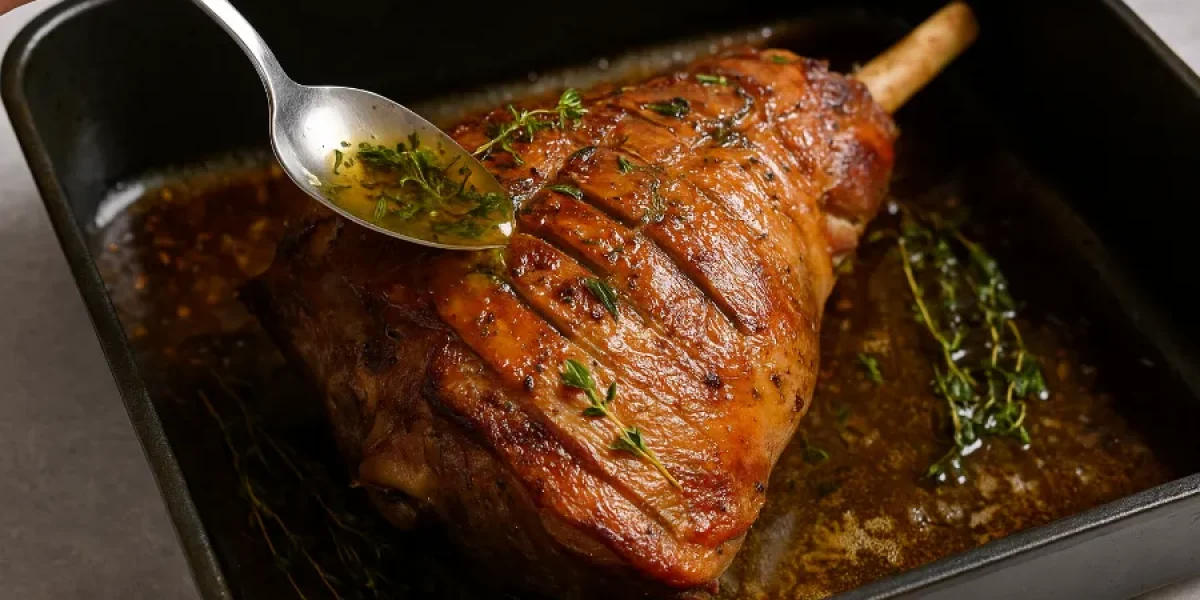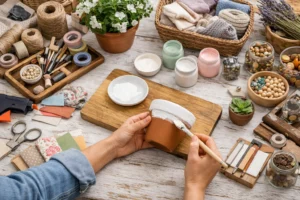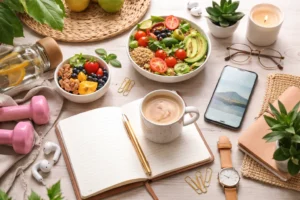There’s something almost sacred about making roast lamb. It’s that one dish that makes your kitchen smell like a Sunday worth slowing down for. But as magical as it sounds, there are plenty of common mistakes when cooking roast lamb that can turn your dreams of tender, flavorful perfection into a dry, chewy disappointment.
I’ve been there — too many times. My early roasts were experiments gone sideways: overcooked legs, greasy shoulders, and bland meat that deserved better herbs. But after years of testing, failing, and re-learning, I’ve come to realize that mastering a roast lamb recipe isn’t about memorizing steps — it’s about understanding what not to do.
So here’s my honest guide, drawn from countless roasts, about where home cooks (and even pros) go wrong — and how you can make your next lamb roast the one that wins you bragging rights.
Roast Lamb Recipe: The Foundation of Flavor
Let’s start with the big picture: the roast lamb recipe itself. Everyone has their own version — some swear by garlic and rosemary, others by spice rubs and lemon zest. But even the best recipe falls apart if the basics aren’t right.
One of the biggest rookie mistakes? Treating all cuts of lamb the same. A leg of lamb and a lamb shoulder may look similar in size, but they couldn’t behave more differently in the oven. The leg is lean and elegant — it loves precision and medium-rare timing. The shoulder, on the other hand, is fatty and forgiving; it wants long, slow heat that melts the collagen into silky tenderness.
Mistake to avoid: Cooking a shoulder like a leg or a leg like a shoulder.
Pro fix: Choose your method based on your cut.
- For a leg of lamb, start hot (around 425°F/220°C for 15 minutes), then lower to 350°F/175°C.
- For a lamb shoulder, slow and low is your friend — 300°F/150°C for hours until it falls apart.
That one change alone separates a good roast from a great one.
Cooking Lamb: The Home Cook vs. The Pro
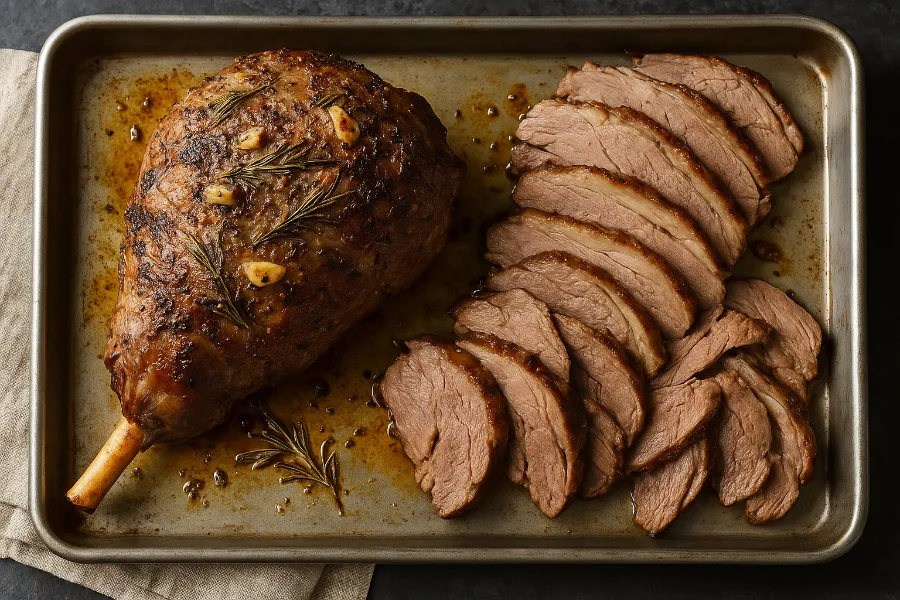
Here’s something I’ve learned over time — cooking lamb is less about the recipe and more about rhythm.
As a home cook, I used to think I had to follow instructions word-for-word. Set the timer, trust the oven, pray for the best. But professionals? They watch, smell, and listen. They don’t follow the roast — they lead it.
Amateur Mistakes
- Relying solely on time, not temperature.
- Not letting the meat rest before carving.
- Skipping the basting (because “who has time for that?”).
- Using a cold roast straight from the fridge.
Pro Habits
- They always rest the lamb before roasting (30–45 minutes at room temp).
- They baste religiously — every 25 minutes, no excuses.
- They use a meat thermometer, not a guess.
- They treat the oven as a tool, not a mystery box.
But here’s the thing — being a “home cook” isn’t a disadvantage. You have freedom. You can experiment, taste, and learn at your own pace. The trick is blending your curiosity with a bit of professional discipline. Once you do that, your lamb roast goes from “good enough” to “where did you learn to cook like this?”
Lamb Roast: The Little Details That Matter Most
I’ve come to believe that a lamb roast is 80% setup and 20% patience. If your prep is solid, the oven will do the rest.
Here are the top mistakes I see (and made) over the years:
1. Not Seasoning Deeply Enough
A quick sprinkle of salt on the outside isn’t enough. Lamb is rich and earthy — it needs seasoning inside out. Score the fat lightly and rub garlic, rosemary, thyme, or mint paste into every crevice.
2. Skipping the Rest
I used to slice immediately out of excitement (and hunger). Big mistake. That five-minute rest? It’s a lie. Lamb needs 15–20 minutes under foil to let juices redistribute. Slice too soon, and all that flavor ends up on the cutting board.
3. Overcrowding the Pan
You want roast, not steam. Give your lamb room to breathe. If you’re cooking vegetables alongside it, add them later or roast separately for better browning.
4. Ignoring the Pan Juices
Please — don’t toss them. Those caramelized bits are the base of your sauce. A quick deglaze with wine, stock, or even water, and you’ve got instant flavor gold.
Leg of Lamb: The Elegant Challenge
If there’s one cut that exposes a cook’s skill, it’s the leg of lamb.
It’s lean, it’s beautiful, and it’s brutally honest — it shows every mistake. Cook it even five minutes too long, and it goes from succulent to stringy. Undercook it, and you’ll be carving around raw sections.
Mistake #1: Treating It Like Beef
Lamb isn’t steak. It carries more natural flavor and cooks faster. Medium-rare (around 135°F/57°C internal) is where it shines — pink, juicy, and tender.
Mistake #2: Forgetting to Rest
If you’re serving a leg, presentation matters. Resting not only locks in moisture but makes carving cleaner. That’s how pros get those perfect, uniform slices.
Mistake #3: Neglecting Fat
Keep a thin layer of fat intact. That’s where the flavor caramelizes and the crust forms. Trim too much and you’ll miss out on that signature golden edge.
Pro tip: If you’re nervous about overcooking, use a digital probe thermometer. It’s the difference between guessing and mastering.
Lamb Shoulder: The Home Cook’s Secret Weapon
Now, let’s talk about lamb shoulder.
This is the cut that forgives — and rewards. If you’re new to roasting lamb, this should be your go-to. It’s fatty, flavorful, and almost impossible to mess up if you give it time.
Why Home Cooks Love It
- The fat content self-bastes the meat as it cooks.
- It’s cheaper than the leg but often more flavorful.
- It’s flexible — roast it, braise it, or shred it for sandwiches.
The Common Mistake
Rushing it. Shoulder needs hours, not minutes. A 4-pound shoulder can take 3–4 hours at 300°F, but it will reward you with silky, pull-apart perfection.
Add a splash of broth or wine midway through roasting and cover loosely with foil for part of the cook. The steam will tenderize it, while the uncovered finish will crisp the top beautifully.
Internal Lamb Temperature: The Heart of the Roast
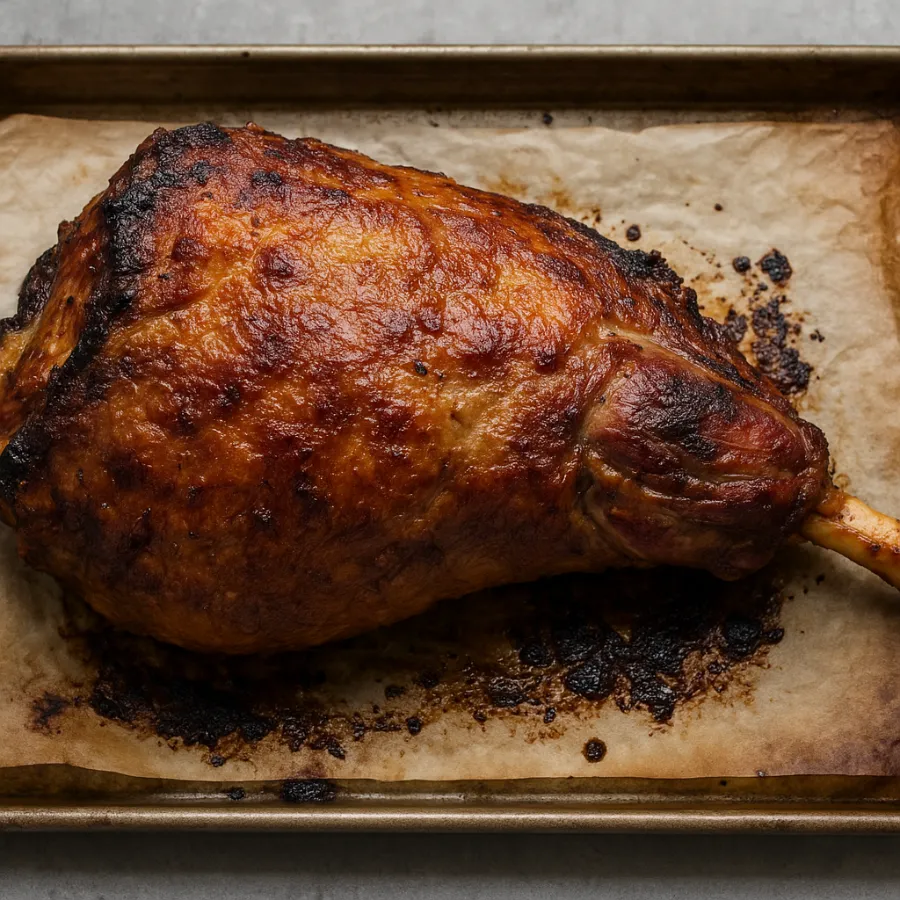
If there’s one number that matters more than any other, it’s your internal lamb temperature. I used to rely on color — pink meant good, brown meant done — until I learned that every oven lies and every cut cooks differently.
Here’s your temperature cheat sheet (print this one if you need to):
| Doneness | Internal Temperature | Texture |
|---|---|---|
| Rare | 125°F (52°C) | Deep pink, juicy |
| Medium Rare | 135°F (57°C) | Tender, balanced flavor |
| Medium | 145°F (63°C) | Slightly firm but moist |
| Well Done | 160°F+ (71°C) | Fully cooked, less juicy |
And for slow-roasted lamb shoulder, aim for 190°F (88°C) — it’ll shred with a fork.
The pros don’t guess — they check. Every time. It’s not a sign of inexperience; it’s a sign of respect for the meat.
The History and Practice of Basting
Ah, basting — the most ancient and oddly poetic part of cooking lamb.
Long before ovens existed, people roasted meat over open flames, catching dripping fat and spooning it back over the meat to keep it moist. In medieval kitchens, cooks basted lamb with ale, butter, and herbs using bundles of twigs. In the Middle East, they brushed yogurt and spiced oils over lamb roasting on spits — both to flavor and to protect.
Today, we think of basting as optional — but it’s actually the soul of the roast. It’s what gives lamb that burnished, glossy look and deep, savory aroma that pulls everyone into the kitchen.
Modern Basting Tips
- Wait until your crust forms before basting (around 30 minutes in).
- Use fat, not watery liquids — melted butter, olive oil, or rendered lamb fat work best.
- Add herbs like rosemary or thyme to your basting mix for aroma.
- Baste every 20–25 minutes until done.
It’s not just about flavor — it’s connection. Every time you open the oven door to baste, you’re joining a tradition as old as cooking itself.
The Advantage (and Disadvantage) of Home Cooks vs. Pros
Here’s something I wish someone told me years ago: professionals and home cooks aren’t opposites. They’re two sides of the same kitchen coin.
Professionals have discipline, consistency, and precision.
Home cooks have passion, intuition, and adaptability.
The disadvantage of a pro? They rarely get to experiment — they must deliver perfection every time.
The disadvantage of a home cook? They often don’t measure what works — so it’s hard to repeat success.
The magic happens when you blend both:
Cook with a pro’s precision but a home cook’s soul. That’s where truly great lamb comes from.
Final Thoughts: Turning Mistakes into Rituals
Every bad roast I’ve made — every dry leg, every greasy shoulder — taught me something. Cooking lamb isn’t about avoiding failure; it’s about earning confidence.
Now, when I pull a lamb from the oven, I don’t panic. I listen. The crackle tells me the fat’s done its job. The aroma says the herbs have bloomed. And when I slice — after resting, of course — and see that perfect blush of pink, I know I didn’t just cook dinner. I honored a ritual that’s older than language itself.
So if you’re nervous about your next roast lamb, don’t be. Just remember:
- Start with the right cut.
- Mind your temperature.
- Baste like you mean it.
- And never skip the rest.
Because a perfect lamb roast isn’t about perfection — it’s about attention.
FAQs
The biggest mistakes are overcooking, skipping the rest period, under-seasoning, and not using a thermometer. Each step affects tenderness and flavor.
Check the internal lamb temperature with a thermometer. Aim for 135°F (57°C) for medium-rare or 145°F (63°C) for medium.
Yes! Basting every 20–25 minutes keeps the meat juicy and helps form a beautiful golden crust. Use melted fat or olive oil infused with herbs.
A leg of lamb gives a lean, elegant roast perfect for slicing, while a lamb shoulder is richer and more forgiving, great for slow roasting.
Dryness usually comes from overcooking or slicing too soon. Always rest the lamb for 15–20 minutes after roasting to retain its juices.
Pros rely on thermometers, basting, and precise timing. Home cooks can match that level by paying attention to temperature, seasoning, and rest time.
Absolutely. You can season it a day ahead and let it marinate in the fridge. Just bring it to room temperature before roasting for even cooking.

